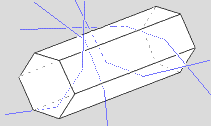
OPOD
What's New
Rays & Shadows
Water Droplets
Rainbows
Ice Halos
Contents
Crystals
Frequent Halos
Infrequent Halos
Why infrequent?
46° Halo
Supra/infralateral
Parry Arcs
Images
Lowitz Arcs
Moilanen Arc
Kern Arc
120° Parhelia
44° Parhelia
Subhorizon Arcs
Pyramidal
Multiple Displays
Other Worlds
Observing Halos
HaloSim
High Atmosphere
Links & Resources
Search - Index
123456789012345678
| Parry Arcs |
 |
| The
changing aspect of Parry arcs with solar altitude. Faint 22� halos
and upper tangent arcs (UTA) are included for reference in these HaloSim
simulations. At 0� a 'sunvex' Parry arc is almost coincident with
the UTA. As the sun rises the sunvex arc separates upward and a 'suncave'
Parry arc appears and approaches the UTA. Above 25� a lower sunvex
arc becomes visible. To see this rare halo, anticipate its appearance at the sun's actual altitude - distinguish also between it and halos from pyramidal crystals or even Lowitz arcs. |
The high degree of orientation produces many different and rare halos. Parry arcs proper result from ray paths through prism side faces inclined at 60�. There are four possibilities and the Parry arcs are called 'suncave' or 'sunvex' depending whether they are concave or convex with respect to the sun. |
||
